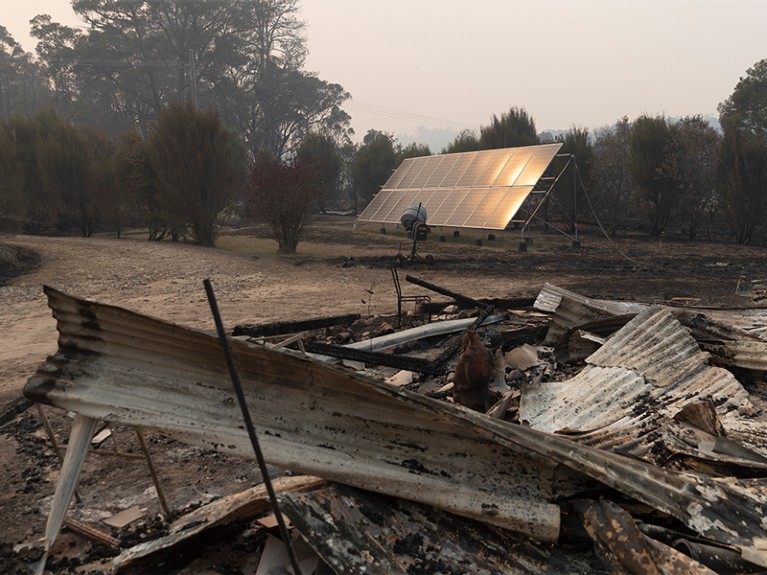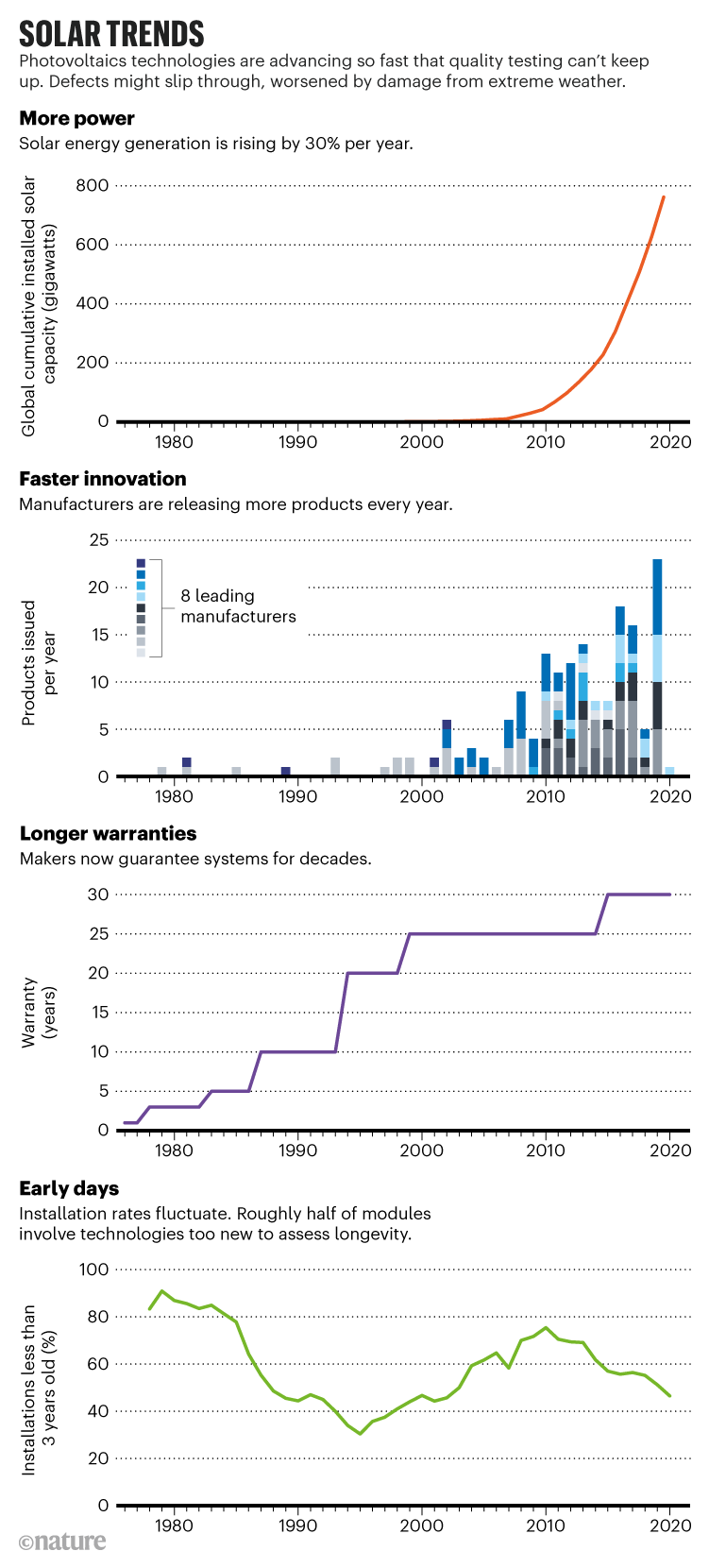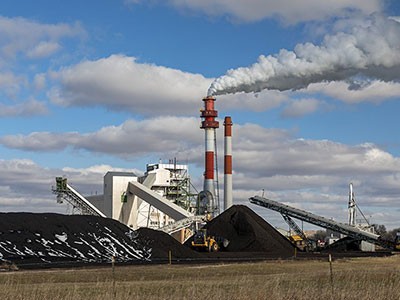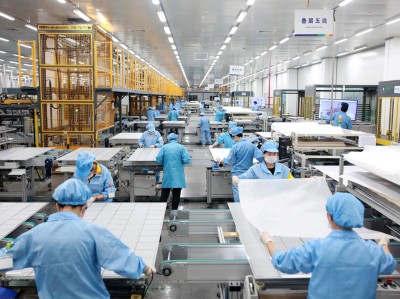
Only solar panels remain intact after a bush fire burnt down a property in Torrington, Australia, in 2019.Credit: Brook Mitchell/Getty
Solar energy is being adopted the world over. Prices have plunged 100-fold since 1980. By 2023, the installed capacity of photovoltaics globally is expected to surpass 1 terawatt — 30–100 TW will be required by 2050. Yet colliding trends mean that many of the technologies being installed today might not last until then if quality is not assured.
To displace fossil fuels, solar energy needs to be dependable. Photovoltaic technologies must function as well in the steamy tropics as at the icy poles — working through storms, hail, heatwaves and snow. Until now, solar energy has been very reliable. Most modules have warranties that last 25–35 years (see ‘Solar trends’), and less than 1% of those in the United States fail within the first 5 years1. Intact solar panels were crucial, for example, in helping small island states to recover after devastating hurricanes in the Caribbean in 2017.
Yet, reliability challenges loom. Solar energy systems are being installed in more diverse settings. New cell designs, materials, packaging and racking technologies are advancing to market within months. Durability testing needs to keep up. Some components that passed quality tests a decade ago have since turned out to be defective.
Today’s sophisticated systems are more efficient, but there is also little room for error. Manufacturers striving for higher energy yields and lower costs are making modules larger and thinner. They are connecting many cells together to boost power and speed up production. The electronics are more complex. Disruptions to supply chains might tempt some makers to use cheap, substandard or counterfeit components (see go.nature.com/3kptewj). Poor installation, operations and maintenance practices cost utility firms tens of millions of dollars a year in lost power generation (see go.nature.com/3xnyfef). Over decades, that could amount to billions.

Sources: Power, VDMA 2020 International Technology Roadmap, 11th edn; Warranties, Updated from D. C. Jordan & S. R. Kurtz Prog. Photovolt. 21, 12–29 (2011); Innovation & early days, D. Jordan
Solar panels are also increasingly exposed to extreme weather whipped up by climate change. During a storm in Texas in 2019, hailstones nearly 7 centimetres across shattered modules powering around 20,000 homes. Insurance losses exceeded US$75 million.
Unaddressed, such vulnerabilities will slow the roll out of solar energy. Key climate milestones could be missed. The sector will face higher insurance claims, lost revenue and financial and safety risks. Grid operators will be reluctant to switch to solar. Carbon-neutral targets will be missed.
And in the short term, solar power could save lives. For example, when 10 million people lost electricity during Texas’s big freeze in February, at least 111 people died and the damage in the state amounted to $130 billion. Thermal generation crashed and wind generation underperformed, but solar power production was largely unaffected2 and continued to generate 2% of the state’s energy.
Here, we set out five steps the solar sector needs to take to assure the dependability of solar energy — including installation checks and training, basic research on materials and system failures and more robust operations and standards. Solar-energy scientists and engineers, investors, consumers and governing bodies all have a role.
Boost science
Laboratory tests and computer models need to be advanced to assess how well the next generation of modules will perform in the field.
Researchers need to better understand the physics and chemistry of degradation. One challenge is the acceleration of subtle processes involving diffusion and reactions of chemical species. Heating samples or amplifying stresses by, for instance, exposing the samples to 100% humidity or intense ultraviolet light, can produce misleading results if reactions are triggered that don’t occur in the field. Once-popular ‘pressure cooker’ tests of panels can give the wrong impressions for this reason. Tests need to expose faults in a more realistic way. They should, for example, apply many stressors at once, in naturalistic sequences, and include more extreme conditions.
Eight priorities for calculating the social cost of carbon
Failure mechanisms need to be identified, as do strategies for minimizing them. For example, solar modules at the ends of strings connected in series experience higher voltages than do those in the middle. Those voltages could be high enough to free sodium ions in the glass cover, which might then drift into the solar cell and overwhelm it. Similarly, researchers must understand why and how light and heat degrade various types of cell in different ways; hydrogen is thought to have a role.
Larger and more-complex testing facilities are needed. These must deliver uniform levels of light, heat and other stressors to panels that now cover several square metres and take two or more people to position. Panels in the 1980s spanned only around 0.5 m2 and were easier to handle. Multiple panels need to be tested at once, to ensure the statistical significance of conclusions. Many national and top-tier testing labs, including ours in the United States and others in Europe and Asia, have these capabilities. Few small buyers or testers in low-income countries have such access.
Strengthen standards
Quality standards are widely used to verify individual components, such as a panel, diode or junction box. None covers an entire solar energy system. Poor assembly practices, differences in components between batches and the inclusion of even one unqualified component can all ruin performance.
To guide more holistic standards, the durability of whole systems needs to be tested. As a first step, in 2014, the International Electrotechnical Commission (IEC) began to form a global certification system for renewable-energy applications (IECRE), which reported its first photovoltaics certificate in 2016. It needs to be expanded. Oversight must extend beyond factory and product inspections. Random sampling and compliance testing must be introduced at every stage of the supply chain, as happens in the food industry. Customers should demand certified products and methods when they buy.
Standards need to be updated continually to address the latest technologies and failure modes. The current development cycle, which relies on reaching consensus in international teams of volunteer experts, is too slow and often takes years. Full-time technical support is needed in every member country of the IEC.

A pile of solar panels blown out of place during Hurricane Irma in the US Virgin Islands in 2017.Credit: Jessica Rinaldi/The Boston Globe/Getty
Harsher test conditions also need to be considered, to predict failures over longer periods and to account for increasingly severe weather. Current IEC standards require modules to withstand hailstones 25 millimetres across. Certifications involving larger ice balls are being developed, but researchers still need to establish a realistic range of conditions to be tested, while keeping product costs low and avoiding overdesign. One solution is to introduce specialized certifications of systems that are tailored to harsh conditions in specific regions.
Components such as modules, inverters and connectors must be exposed to a range of stressors at the same time in tests, as they would be outdoors. Otherwise, defects could be missed. For example, when 6.5 million modules were sampled from more than 350 international sites in 2019, 14% had degraded backsheets, with problems ranging from discolouration to cracking3. Unforeseen issues with one type of backsheet (made of a type of AAA polyamide) illustrate the wider problem. Introduced to the market in 2010, these components became popular because they were relatively cheap, and conventional backsheets were facing supply-chain problems. AAA panels passed standard tests for exposure to damp heat and ultraviolet light. But five to ten years later, many began to crack, causing short circuits. Thermomechanical stresses from manufacturing and outdoor exposure, not previously part of standard tests, were eventually found to be the culprit4. These factors are now being incorporated into testing.
Researchers must develop tests and standards for unexpected failures. For example, new forms of low-temperature solder degrade through a different mechanism from conventional solders and thus require a different testing protocol5. Floating photovoltaics, installed on water, will need more corrosion-resistant materials for connectors and brackets, and wave motion could speed up wear and tear. Tests are needed to define when it is acceptable to mix and match components: fires can occur when installers plug together connector parts from different manufacturers.
Monitor changes
Early identification of faults using sensors and monitoring needs to be routine in the solar industry, as it is for conventional energy generators and wind turbines. Some operators of large solar arrays already use infrared or visible cameras flown on drones and aircraft to spot faults. However, they need better analytical methods to interpret data quickly, and then respond rapidly to mitigate production losses and damage. Machine-learning algorithms are a promising way to detect slight underperformances that could be masked by larger diurnal and seasonal changes.
Net-zero emissions targets are vague: three ways to fix
More comprehensive technologies are needed — these would track meteorological predictions along with data from on-site wind sensors, accelerometers and video, for example. Many large solar-power systems have a dedicated weather station, measuring solar irradiance, temperature and wind. Some also follow weather forecasts. Operators sometimes stow arrays when hail or high winds threaten. Attaching vibration sensors would allow them to make finer adjustments to reduce the impacts of ice, high winds or snow. On a smaller scale, sensors could be integrated into modules to reveal physical or chemical changes that might warn of reliability concerns later; some versions have been demonstrated6.
Adding sensors and monitoring systems to solar arrays will increase costs. But over decades, these investments will be recouped by lowering maintenance needs and downtime.
Track materials
Content information is typically not shared in the competitive, low-margin solar market. Few producers, if any, report how a panel has been manufactured, or list what it is made of. Supply-chain bottlenecks — such as those stemming from the COVID-19 pandemic for backsheets, polysilicon and glass— are hitting the photovoltaics industry hard. Consumers have no way of knowing whether manufacturers have made last-minute substitutions with untested components. Buyers with strict contract deadlines could turn a blind eye to avoid penalties. Such uncertainties also cloud the conclusions that scientists draw from lab tests.
Protect global supply chains for low-carbon technologies
Developers, buyers and testers should request accurate information on module content — the bill of materials. Manufacturers should provide it as a customer service. For example, when operators at a large utility site in New Jersey investigated the 12% of modules that were underperforming, they found that the problem stemmed from variations in the silver paste top contact on different cells in the same module7. Transparency would also facilitate recycling and rebuilding of old solar panels, opening markets and reducing landfill.
The solar sector should look to other industries in which reliability is key. For example, aviation insists on rigorous inspection, maintenance and materials control. Data on materials degradation or failure are shared openly, because the entire industry depends on safety.
Regulation of labelling requirements should also be considered, as it is for foods. International organizations such as the IEC System of Conformity Assessment Schemes for Electrotechnical Equipment and Components (IECEE) could assist — they already monitor consistency of manufacturing for some certified solar equipment.
Educate community
Although electrical-safety requirements are common in developed countries, many parts of the world don’t have or abide by them. There are also inconsistencies that affect reliability. Best practices need to be communicated and adopted worldwide. For example, in hurricane-prone regions, simple steps can increase the likelihood of a system surviving. These include: using strong support structures rated for storm wind speeds; through-bolting frames or using more mounting clips per solar panel; using vibration-resistant bolts; mounting brackets into the rafters and not just into the roof; and avoiding locating the system close to the roof edge, to minimize uplift8.
Proper handling and shipping are essential. Walking on modules that are not designed for it, resting the soft backsheet underside of a solar panel on a hard hat, shipping horizontally, twisting panels or other rough handling can cause invisible damage.
Other common problems include improper wiring, and issues with fuses, breakers and connectors. Inverters, which convert direct current to alternating current, are what most often fail. Exposure to heat is often the reason. There’s a simple remedy: lengthen connectors and install the inverters on a shady side of the building, rather than in full sun.
Commitment to the quality of photovoltaic systems is essential across the value chain. It must include rigorous training for solar installers and state of the art maintenance and operation. Certifications should be provided that solar consumers can recognize. The North America Board of Certified Energy Practitioners (NABCEP) offers certifications and training for solar installers and has recently expanded internationally. Similar organizations are needed globally. A digested form of the IECRE quality certification system should be provided for consumers and homeowners.
All these quality-assurance measures are cost-effective, compared with the price of climate change. Power outages in the United States from hurricanes in 2018 alone cost $150 billion and this year’s flooding in Germany in excess of €10 billion (US$11.3 billion). Investment in quality control now will assure decades of affordable clean electricity to come.

 Protect global supply chains for low-carbon technologies
Protect global supply chains for low-carbon technologies
 Net-zero emissions targets are vague: three ways to fix
Net-zero emissions targets are vague: three ways to fix
 Eight priorities for calculating the social cost of carbon
Eight priorities for calculating the social cost of carbon
 Microsoft’s million-tonne CO2-removal purchase — lessons for net zero
Microsoft’s million-tonne CO2-removal purchase — lessons for net zero
 Share data on wind energy
Share data on wind energy








